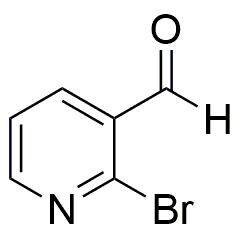2-Bromonicotinaldehyde is widely utilized in research focused on:
- Synthesis of Pharmaceuticals: This compound serves as a key intermediate in the synthesis of various pharmaceutical agents, particularly those targeting neurological disorders, enhancing drug development efficiency.
- Organic Synthesis: It is used in organic chemistry for the preparation of complex molecules, allowing chemists to create diverse compounds with specific properties for research and industrial applications.
- Material Science: The compound is applied in the development of advanced materials, such as polymers and coatings, which benefit from its unique chemical properties, leading to improved performance in various applications.
- Agricultural Chemistry: 2-Bromonicotinaldehyde is explored for its potential use in agrochemicals, contributing to the development of effective pesticides and herbicides that are more environmentally friendly.
- Fluorescent Probes: This chemical is utilized in the creation of fluorescent probes for biological imaging, facilitating research in cellular biology and diagnostics by providing clearer visualization of cellular processes.
General Information
Properties
Safety and Regulations
Applications
2-Bromonicotinaldehyde is widely utilized in research focused on:
- Synthesis of Pharmaceuticals: This compound serves as a key intermediate in the synthesis of various pharmaceutical agents, particularly those targeting neurological disorders, enhancing drug development efficiency.
- Organic Synthesis: It is used in organic chemistry for the preparation of complex molecules, allowing chemists to create diverse compounds with specific properties for research and industrial applications.
- Material Science: The compound is applied in the development of advanced materials, such as polymers and coatings, which benefit from its unique chemical properties, leading to improved performance in various applications.
- Agricultural Chemistry: 2-Bromonicotinaldehyde is explored for its potential use in agrochemicals, contributing to the development of effective pesticides and herbicides that are more environmentally friendly.
- Fluorescent Probes: This chemical is utilized in the creation of fluorescent probes for biological imaging, facilitating research in cellular biology and diagnostics by providing clearer visualization of cellular processes.
Documents
Safety Data Sheets (SDS)
The SDS provides comprehensive safety information on handling, storage, and disposal of the product.
Product Specification (PS)
The PS provides a comprehensive breakdown of the product’s properties, including chemical composition, physical state, purity, and storage requirements. It also details acceptable quality ranges and the product's intended applications.
Certificates of Analysis (COA)
Search for Certificates of Analysis (COA) by entering the products Lot Number. Lot and Batch Numbers can be found on a product’s label following the words ‘Lot’ or ‘Batch’.
*Catalog Number
*Lot Number
Certificates Of Origin (COO)
This COO confirms the country where the product was manufactured, and also details the materials and components used in it and whether it is derived from natural, synthetic, or other specific sources. This certificate may be required for customs, trade, and regulatory compliance.
*Catalog Number
*Lot Number
Safety Data Sheets (SDS)
The SDS provides comprehensive safety information on handling, storage, and disposal of the product.
DownloadProduct Specification (PS)
The PS provides a comprehensive breakdown of the product’s properties, including chemical composition, physical state, purity, and storage requirements. It also details acceptable quality ranges and the product's intended applications.
DownloadCertificates of Analysis (COA)
Search for Certificates of Analysis (COA) by entering the products Lot Number. Lot and Batch Numbers can be found on a product’s label following the words ‘Lot’ or ‘Batch’.
*Catalog Number
*Lot Number
Certificates Of Origin (COO)
This COO confirms the country where the product was manufactured, and also details the materials and components used in it and whether it is derived from natural, synthetic, or other specific sources. This certificate may be required for customs, trade, and regulatory compliance.


